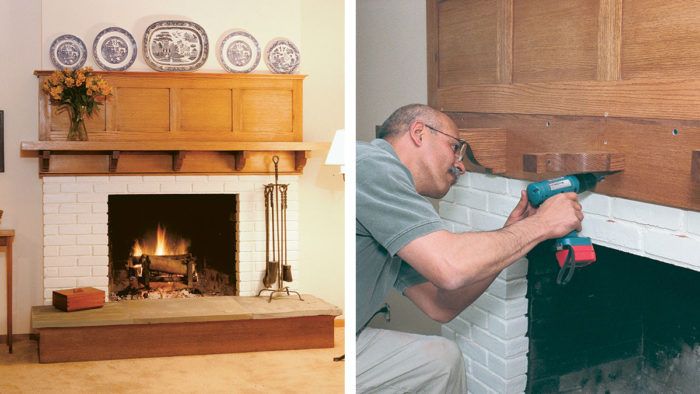A Mantel with a Mission
Arts andCrafts-style overmantel beautifies a tract-house fireplace
Synopsis: Mario Rodriguez designed an overmantel that’s simply built with four panels and a 2-1/4-in thick mantel shelf. The shelf rests on five brackets that are all directly in line with the stiles on the overmantel. The article includes instructions on building a complementary wooden skirt around a raised hearth, which Rodriguez topped with slabs of bluestone. He sped construction by making a single groove to serve as both the mortise for the tenons and the groove to hold the panel. Rodriguez used plywood with a solid frame for the overmantel, which helps reduce its weight, and he cut all the pieces and finished them ahead of time. A detailed project plan helps clarify all the parts and assembly. The article details three steps in placing a mantel and how to cut and install the brackets. Side information describes how to use glazing gel to make the wood look old.
Some friends of mine live in an attractive but indistinguishable Ranch-style house. Built in the 1970s, it’s a typical tract house, produced cookie-cutter style to fit a tight budget and a streamlined modern lifestyle. They loved the house when they bought it, but they always knew there were a few things they would want to improve. First on their list was to do something with the plain brick fireplace and raised hearth in the living room.
When they came to me looking for a nice wooden mantel, it took some time to find a design that matched the house, the furnishings and the owners’ tastes all at the same time. The raised hearth was originally intended to make a cozy fireplace perch. A nice idea, but it brought up a design problem I’ve never had to deal with before: Exactly what kind of mantel do you install on a raised hearth fireplace?
After looking through a number of books and a lot of experimenting at the sketch board, I decided a simple wrap-around mantel in an Arts-and-Crafts style would work nicely. A wrap-around mantel would enhance the horizontal sweep of masonry, not fight with it. I also considered ease of construction and time and materials. With a little planning, I’d be able to construct the majority of the mantel in my own shop and install the whole job with only a day’s work in my friends’ living room.
The design I settled on calls for a simple fourpanel overmantel and a 21⁄4-in.-thick mantel shelf. I wanted the mantel to appear well-balanced and symmetrical, so I designed the shelf to rest on five brackets that are all directly in line with the stiles on the overmantel.
A bluestone slab on top of the hearth would be an attractive way to cover the brick, and a wooden skirt around the raised hearth would hide the masonry, tying the hearth and mantel together visually. I didn’t want anything to detract from the design or distract the viewer, so I chose rift-cut red oak, both solid and plywood. This combined the rich, rough surface of oak with an inconspicuous dead-straight grain.
From Fine Woodworking #131
For the full article, download the PDF below:
Fine Woodworking Recommended Products


Blackwing Pencils

Drafting Tools





















Log in or create an account to post a comment.
Sign up Log in